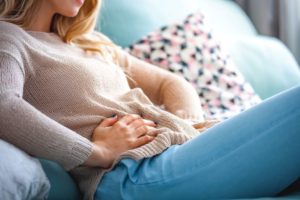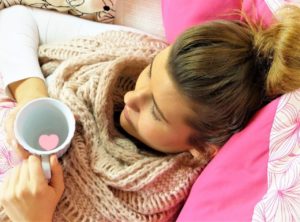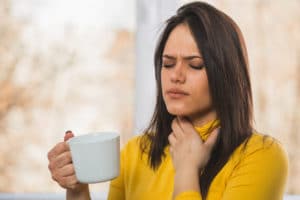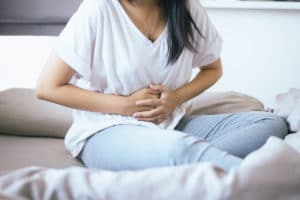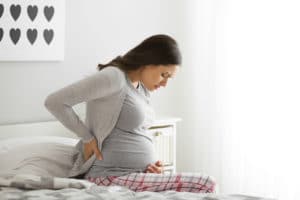Dysmenorrhea, or period pain as it is colloquially known, is familiar to just about every woman. Some feel a slight sinking feeling in the abdomen, others feel listless all day, and still, others can hardly stand up because of the pain.
The abdominal pain can be within normal limits, but it can also get out of hand, such as in women who suffer from endometriosis. Find out everything you need to know about these complaints here.
Table of contents
What Is Dysmenorrhea?
Dysmenorrhea is the colloquial term for menstrual pain. It belongs to the group of menstrual cramps and, along with premenstrual syndrome (PMS), is one of the most common problems experienced by menstruating women. Menstrual cramps are also called molimina menstrual (Latin) – “molimina” means discomfort.
Dysmenorrhea should not be confused with other menstruation-related disorders such as amenorrhea (absence of periods), hypomenorrhea (very weak periods), or hypermenorrhea (very heavy periods). Dysmenorrhea is specifically severe abdominal pain during the period.
In particular, the first two days of menstruation are described as especially painful. Not all women suffer from dysmenorrhea. There are women who hardly notice their period and women who suffer so much from the pain that they cannot go to work or school.
The Different Types Of Dysmenorrhea
Pain during menstruation is divided into two categories: Primary and secondary dysmenorrhea. Both categories are described in more detail below.
Primary Dysmenorrhea
Primary dysmenorrhea describes the normal period pain that every woman suffers from to a greater or lesser extent during menstruation. This abdominal pain is directly linked to the period and thus only occurs between menarche (first menstruation in a woman’s life) and menopause (last menstruation in a woman’s life). The cause of the pain is hormones called prostaglandins.
These trigger contractions of the uterus during menstruation so that the mucous membrane, which has already been built up for possible fertilization, can be shed. This leads to the characteristic abdominal pain.
Especially very young and slim women suffer from menstrual pain. Other symptoms associated with primary dysmenorrhea include headaches, nausea and digestive disorders.
The severity of primary dysmenorrhea differs from woman to woman. Thus, there are women who hardly feel their period, while others are even unable to work these days. There are even countries where every woman is allowed to stay at home for up to three days every month.

Secondary Dysmenorrhea
Secondary dysmenorrhea is period pain caused by illness or irritation.
Mechanical Contraceptives
If you are using intrauterine device or diaphragm for contraception, this may be the reason for secondary dysmenorrhea. Irritation of the tissue can cause irritation that triggers painful periods.
Fibroids
Another reason for secondary dysmenorrhea is fibroids. Myomas are benign tumors of the uterine muscles. About a quarter of all women 30 years and older have at least one fibroid in the uterus, but not every tumor causes symptoms.
Cysts
Cysts can also lead to secondary dysmenorrhea. Cysts are fluid-filled cavities surrounded by tissue. They are not dangerous and may occur without symptoms.
Endometriosis
An important cause of secondary dysmenorrhea is endometriosis. This chronic disorder is the second most common gynecological disorder of all after fibroids. In endometriosis, uterine mucosa also forms outside the uterus, for example in the vagina or in the abdominal cavity.
This mucous membrane changes during the menstrual cycle in the same way as the mucous membrane in the uterus and can therefore also trigger the same symptoms. Endometriosis can sometimes be responsible for very intense abdominal pain.
The more severe the disease is and the more foci are found in the woman’s body, the more intense the pain can become.
What You Can Do Against Dysmenorrhea
Dysmenorrhea should be taken quite seriously since it occurs once a month after all. But don’t worry, there are many ways and means to relieve the annoying pelvic pain.
Natural Medicinal Plants
Nature offers a variety of plants that have a natural analgesic and antispasmodic effect. Monk’s pepper, for example, is used to regulate menstruation and also against PMS.
St. John’s wort has a relaxing effect, as does yarrow, which also works against germs and regulates the menstrual cycle. Lady’s mantle also has an analgesic effect, and lemon balm as well as chamomile calm and relax.
Goose cinquefoil, evening primrose and black cohosh are antispasmodic plants. All these herbs can be drunk as tea infusions. However, there is also a selection of powdered mixtures available in pharmacies.
Medication
If the herbal preparations are not sufficient, you can also resort to synthetic painkillers. Here, it is best to choose a medication with acetylsalicylic acid or ibuprofen as the active ingredient. Both inhibit the formation of prostaglandins and thus the cramps of the uterus.
Apply Heat
Heat always has an analgesic, antispasmodic and relaxing effect. So treat yourself to a hot bath during your period, for example. The warm water will help you to relax physically as well as mentally and get rid of the abdominal pain. You can also take a hot water bottle to bed, use a cherry stone pillow or go to the sauna.
Minerals And Nutrients
An adequate intake of magnesium also has an antispasmodic effect. You should make sure you get enough magnesium in your diet. Foods such as nuts, legumes and brown rice contain a lot of magnesium. You can also take dietary supplements.
Taking iron is also recommended shortly before and during menstruation. The loss of blood can lead to iron deficiency, which in turn is responsible for fatigue and weakness. Iron is mainly found in red meat, legumes, millet or spinach, but can also be taken as a dietary supplement.
Relaxation
Since menstruation-related abdominal pain is mainly due to uterine cramps, it is important to relax. Stress leads to feelings of tension throughout the body and is therefore to be avoided, especially during menstruation.
Relaxation is a complex word. Nowadays, there are many offers such as yoga groups or autogenic training courses.
Meditation can also help to come down from an increased stress level and to relax the whole body. In alternative medicine, acupuncture and reflexology are very effective against pain and cramps.
However, you can also achieve relaxation in many other ways. You know best how to take care of your well-being. Maybe snuggled up on the sofa with a hot water bottle, tea, and a good book? Or with a radio play in the bathtub?
Sources
https://www.gesundheit.gv.at/krankheiten/sexualorgane/weibliche-hormone-zyklus/regelschmerzen
https://www.medmix.at/Dysmenorrhö-zeigt-vielfaeltige-symptome/


